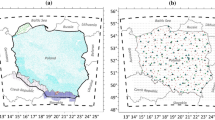Abstract.
Bathymetry data from Sognefjord, Norway, have been included in a terrain model, and their influence on the geoid has been calculated. The test area, located in the western part of Norway, was chosen due to its deep fjords and high mountains. Inclusion of bathymetry data in the terrain model altered the computed gravimetric geoid by as much as a few decimeters. The effect was detectable to a distance of more than 100 km. All calculated geoids, both with and without bathymetry data in the terrain model, fit the geoidal heights determined by available Global Positioning System (GPS) and levelling heights at the sub-decimetre level. Contrary to expectations, the accuracy in geoid prediction was reduced when using bathymetric data. The geoid changes were largest over the fjord where no GPS points were located. Different methods on the same area [isostatic and Residual Terrain Model (RTM)-terrain reductions] showed differences of approximately 1 m. Rigorous distinction between quasigeoid and geoid was found to be essential in this kind of area.
Similar content being viewed by others
Author information
Authors and Affiliations
Additional information
Received: 12 May 1997 / Accepted 7 May 1998
Rights and permissions
About this article
Cite this article
Dahl, O., Forsberg, R. Geoid models around Sognefjord using depth data. Journal of Geodesy 72, 547–556 (1998). https://doi.org/10.1007/s001900050193
Issue Date:
DOI: https://doi.org/10.1007/s001900050193




